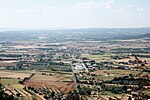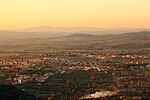Valpiana
Commons category link is defined as the pagenameFrazioni of Massa MarittimaProvince of Grosseto geography stubs

Valpiana is a village in Tuscany, central Italy, administratively a frazione of the comune of Massa Marittima, province of Grosseto, in the area of the Colline Metallifere. At the time of the 2001 census its population amounted to 453.Valpiana is about 45 km from Grosseto and 7 km from Massa Marittima.
Excerpt from the Wikipedia article Valpiana (License: CC BY-SA 3.0, Authors, Images).Valpiana
Piazzetta delle Ferriere,
Geographical coordinates (GPS) Address Nearby Places Show on map
Geographical coordinates (GPS)
| Latitude | Longitude |
|---|---|
| N 43.005 ° | E 10.851388888889 ° |
Address
Piazzetta delle Ferriere
Piazzetta delle Ferriere
Tuscany, Italy
Open on Google Maps









